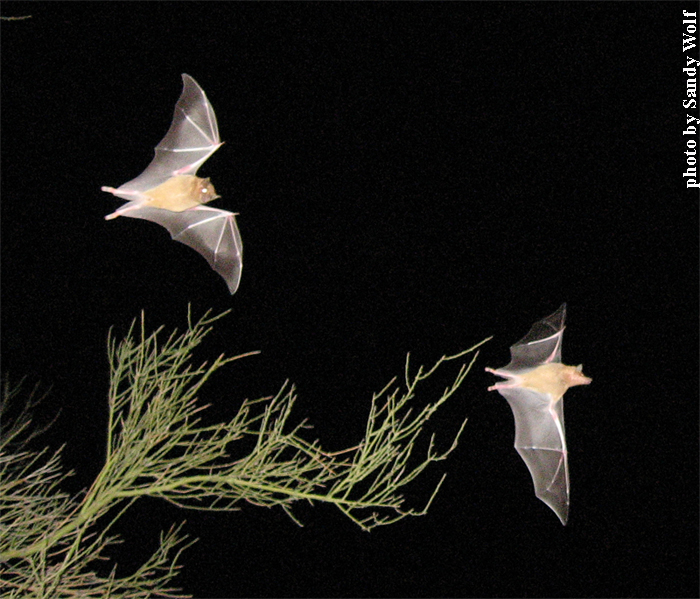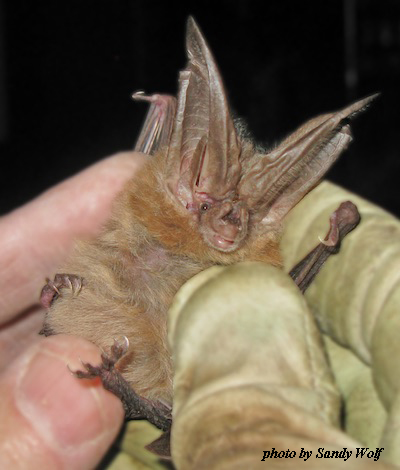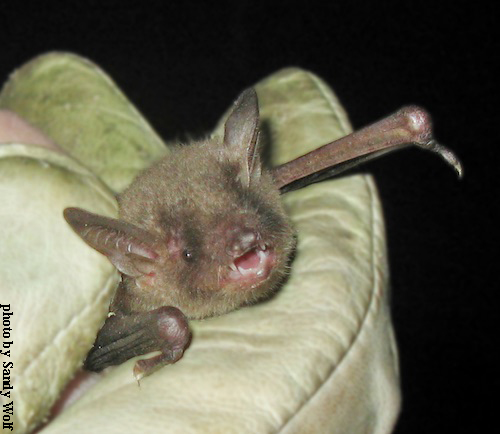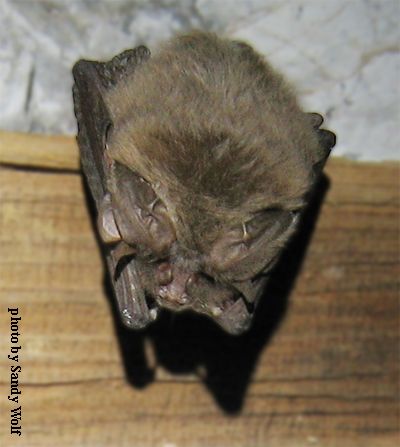Bats of Colossal Cave Mountain Park

Leptos Bats in Flight
Colossal Cave Mountain Park serves as home or way station to almost half the bat species found in the state of Arizona, including some rare and threatened ones.
The females of two of the species winter in hibernation in nearby cooler caverns and crevices, usually at higher elevations. In the spring they move to lower elevations to bear their young in “maternity colonies.” These may be in buildings, mine tunnels, or caverns like Colossal Cave.
The two species are:
– Townsend’s Big-eared Bat, which is listed as threatened in Arizona;
– and the Cave Myotis.

Townsend’s Big-Eared Bat
Both species are insect feeders.
Three bat species use Colossal Cave, not as a nursery, but as a summer home or a stopover point in their migrations:
– Listed as threatened in Arizona is the Mexican Long-tongued Bat. “Choeros” (KY-roes), so called from their species name, Choeronycteris mexicana, are nectar- and pollen-feeders and act as pollinators of saguaro and agave cacti.
Although they do not bear young in Colossal Cave itself, they do elsewhere in the Park. In fact, Colossal Cave Mountain Park and surrounding areas contain the largest number of known maternity roosts for this species.
– The cosmopolitan Pallid Bats use more than one roost each day. Colossal Cave seems to serve them as a day roost, for sleeping. At night, while out hunting, they take their prey to other roosts where they feed and rest between foraging trips.
– “Pips”-the tiny Western Pipistrelles-are also found in the Cave, but seem to come no further than a few feet into the entrances.
Colossal Cave Mountain Park’s remarkable variety of terrains and habitats offers favorable spots other than Colossal Cave for roosting, hunting, and breeding to at least five additional species of bats.
Say “bats” and most of us think “cave.” And, indeed, three of the other Park species often inhabit caves, but are not currently known to use Colossal.

Cave Myotis
Other geologic features—the cracks and crevices in the rocky cliffs, for example—as well as the buildings probably offer shelter to them as they summer in the Park:
Listed as Federally endangered, the gentle Long-nosed Bat feeds mainly on the nectar and ripe fruit of saguaros in late spring and early summer and on the nectar of various agaves in late summer and early fall. So, the “Leptos” (nicknamed from the species name, Leptonycteris curasoae), like the Choeros, are pollinators of saguaros and agaves.
Also summering in the Park is the California Leaf-nosed Bat, which is threatened in Arizona.
Three other bat species dwell at or use the Park’s La Posta Quemada Ranch facility where there is a small wooded riparian area that provides ideal accommodations for their particular needs:
The Western Red Bat roosts in trees. A surprise species found during a recent study, the Western Red Bat is rearing young in the Park.
Another surprise species the study revealed was the Yuma Myotis. These bats prefer rocky crevices close to water—exactly what they find in the cliffs near the riparian area.
The Hoary Bat, an infrequent transient, roosts in unoccupied structures on the way through the Park.
This brings the number of bat species inhabiting Colossal Cave Mountain Park (recorded to date) to 12—an amazing 42.8% of the known species in Arizona—and makes the Park one of the premier bat habitats in the state.
More about bats…

Leptos Bat
There are close to 1,000 species of bats in the world today. Forty-six species are known to reside in North America and of those, twenty-eight occur in Arizona. Bats in the Southwestern United States range in size from the tiny western Pipistrelle (Pipistrellus hesperus), weighing in at about two-tenths of an ounce with an eight-inch wingspan, to the Western Mastiff Bat (Eumops perotis), which boasts a wingspan of about two feet and a weight of 2.1 ounces.
Female bats generally have one pup per year. To give birth to two is rare, and a very few species bear three or four. The pups are born feet first, a unique presentation among mammals. The mother bat hangs by her thumbs, curls her feet and tail membrane upward and inward to make a basket or cradle to catch her baby in.
Economic importance
These shy, gentle, intelligent creatures comprise almost one quarter of all mammal species. Among the least appreciated but most beneficial of mammals, they are a vital part of entire ecosystems—and worth literally billions of dollars to the world economy. For example, approximately 70% of bat species are insectivores (insect eaters). A single colony of bats, numbering from thousands to even millions of individuals, can devour hundreds of tons of insects every night—thus controlling serious crop pests without poison!

Of the remaining species, some bats eat nectar and pollen or fruit, thus pollinating the plants and dispersing seeds. These include important food and lumber plants in Indonesia, Australia, and South America. Here in the desert southwest, bats pollinate agaves, Organ Pipe cactus, and the very symbol of the desert, the giant Saguaro cactus.
Some bat species catch and eat fish. Some eat frogs, and can determine which ones are poisonous by the sound of their mating calls. Some bats eat lizards, rodents, or birds, some eat other bats, and, yes, three species even drink fresh blood—the Vampires.
Vampire bats
Two species of Vampire bat feed from mammals—often livestock—while the third feeds from birds. They don’t actually suck blood. Rather, they pierce the skin with razor-sharp teeth. Natural anticoagulants in their saliva keep the blood flowing as they lap it up. These tiny mammals (weighing in at about an ounce) drink only about two tablespoons in a feeding. Vampire bats are one of the few mammals that will adopt orphaned young or regurgitate blood to feed others in the colony who missed a meal. There are no Vampire bats in the United States or—sorry to disappoint—in Transylvania.
Fiction and fact
We have a number of “bat-isms” in English, cliches that often betray fear and misunderstanding, like “you’ve got bats in your belfry,” “batty,” “took off like a bat out of hell,” and “blind as a bat.”

Townsend’s Big-Eared Bat
Bats are not blind—in fact, they can see very well. They also have great homing instincts and the ability to navigate in total darkness by echolocation. Echolocation is a sensory system by which they emit high-frequency sounds and interpret the echoes bouncing off objects—even as fine as a human hair—to determine distance and location.
Myths about bats abound: for example, bats will get tangled in your hair (untrue), or bats or their guano (droppings) in your hair will cause it to fall out (also untrue), or all bats carry rabies.
Although bats can contract and transmit rabies, it is not as common as with other mammals, like skunks. Rather than becoming aggressive when rabid, bats are weak and unable to fly. Any bat found on the ground is a sick bat. Do not touch it. It may bite in defense if you do. If necessary, use gloves to move it away from children and pets. Interestingly, antibodies found in healthy bats suggest that bats sometimes recover from rabies.
Protection
Historically, the bat’s greatest enemy has been man. People, misunderstanding them, have dynamited, burned, poisoned, and shot millions of bats worldwide. Loss of caves and surrounding habitat, or even disturbance at a bat roost can cause the animals to abandon what had been their home for generations. Disturbing a nursing mother can cause her to drop or abandon her flightless young. Disturbing hibernating bats can cause them to awaken and use up precious fat and energy stored for the winter—consequently, they may starve to death before spring comes.
As people are discovering how beneficial bats really are, they are eagerly joining conservation efforts. These include learning how to exclude bats from buildings without killing them, and putting up bat houses to attract them—thus controlling insect populations without using dangerous pesticides. These gentle mammals deserve our protection—and we, in turn, benefit greatly from their presence.

